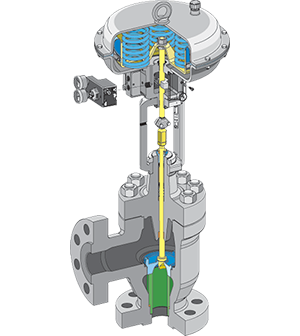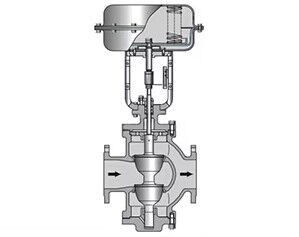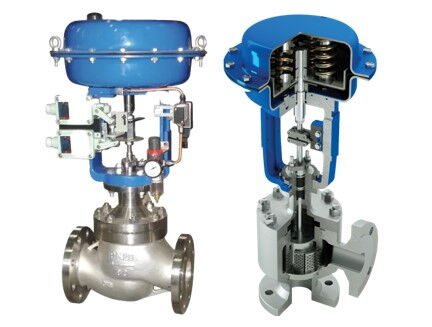Angle Control Valves vs. Double-Seated Control Valves
On this page
Angle control valves and double-seated control valves are two of the most common types of control valves used in industrial systems. They have unique designs, structures, and applications, making them suitable for different tasks. The angle control valve stands out with its 90-degree angle design, which offers simple flow paths and low resistance. This makes it great for handling high-viscosity fluids, fluids with particles, or suspensions. It's especially good at preventing blockages and acid formation. On the other hand, the double-seated control valve is designed for large flow capacities and high-pressure differential handling. It's widely used in systems that need precise control over flow, pressure, and temperature, such as steam, gas, and liquid systems. In this article, we'll dive into the structure, performance, and applications of both control valve types, so you can better understand how to choose and use them.
The design and structure of angle control and double-seated control valves differ significantly, which affects their applications. Even though both valves belong to the same family of control valves and perform similar functions, their design philosophies and performance characteristics make them more suitable for different conditions and requirements.
Design Features: The angle control valve has a unique 90-degree angle design where the fluid enters from the bottom and exits from the side. This simple flow path reduces resistance and helps lower pressure drops, improving flow efficiency.
Applications: Angle control valves are especially effective for handling high-viscosity fluids, fluids with suspended particles, or fluids prone to coking. The design helps prevent particles from collecting inside the valve, reducing the chances of blockages and acid formation. It also offers excellent self-cleaning capabilities.

Design Features: The double-seated control valve uses a straight-through design, meaning the fluid flows along the valve's central axis. It's built with two valve seats, which allows it to handle larger flow rates and lower leakage. This design is perfect for situations that involve high-flow rates and high-pressure differentials.
Applications: Double-seated control valves are ideal for applications that require precise regulation of flow in systems with high flow rates and large pressure differentials. The two-seat design ensures better sealing and stability, making it particularly suitable for controlling gases, steam, and other media.

Angle control and double-seated control valves each have their own performance strengths due to their design differences. Here's a closer look at how each valve performs in fluid control applications.
Simplified Flow Path, Low Resistance: The fluid flows from the bottom and exits from the side. This reduces resistance and pressure drop, resulting in energy savings and better efficiency.
Self-Cleaning Ability: Because the fluid exits from the side, it's less likely to accumulate particles or solids. This prevents fouling and blockages. This self-cleaning feature makes the angle control valve especially good at handling particle-laden, corrosive, or high-viscosity fluids.
Reversed Installation Suitability: In special conditions like high-pressure differentials or when handling particle-laden fluids, the angle control valve can be installed in reverse, meaning the fluid enters from the side and exits from the bottom. Reversed installation helps reduce imbalance forces, minimizes wear, and extends the valve's life. However, long-term operation with small openings should be avoided, as this can lead to unstable vibrations and potential damage.
Large Flow Capacity: Thanks to the straight-through structure and dual valve seats, the double-seated control valve can handle large flow rates. It's perfect for applications with high-pressure differentials and large flow requirements. Its precise control capabilities make it ideal for steam, gas, and liquid systems.
Strong Resistance to Imbalance Forces: The double-seated design balances the impact forces of the fluid, reducing the effects of imbalance forces on the valve stem. This prevents vibration or damage caused by imbalance.
High Stability: The double-seated control valve has a compact structure and quick response time. It offers precise control under high-pressure differentials and low leakage conditions, making it great for applications that require high precision in gas, liquid, and steam control.
There are some differences in the installation and usage of angle control and double-seated control valves, mainly concerning fluid flow direction, installation orientation, opening adjustments, and long-term maintenance. Below are the key installation and usage considerations for each valve type.
Forward Installation: Angle control valves are typically installed with the fluid entering from the bottom and exiting from the side. This is suitable for most standard applications, as it reduces wear and tear on the valve stem.
Reversed Installation: For special conditions, such as high-pressure differentials or fluids with particles, reversed installation (fluid enters from the side and exits from the bottom) is recommended. This helps reduce imbalance forces, minimize wear, and extend valve life. However, avoid prolonged operation with small openings, as this can cause excessive vibrations and damage.
Straight-Through Installation: Double-seated control valves are usually installed with fluid flowing along the valve body's central axis. The installation should align with the valve's design to ensure smooth flow and reduce the risk of valve damage. The double-seated valve is particularly suited for high-flow, high-pressure differential conditions.
Maintenance: The double-seated control valve has a compact design and is easy to disassemble for maintenance. However, regular checks for sealing performance and wear on the valve stem are necessary to ensure the valve operates smoothly and reliably over time.
Because of their unique design features and performance advantages, angle control and double-seated control valves are suitable for different types of fluid control applications. The choice of valve depends on factors such as fluid characteristics, pressure, flow rate, and operating conditions.
High-Viscosity Fluids: Ideal for oils, slurries, viscous liquids, and more.
Fluids with Suspended Particles: Suitable for wastewater, slurries, and similar fluids.
Fluids Prone to Blockages or Acid Formation: Especially useful in industries like chemicals, power, and metallurgy, where temperature and pressure reduction systems are in use.
High-Hardness or Easily Degraded Media: Works well with acidic gases, steam, and similar harsh media.
High Flow and Pressure Differential Applications: Perfect for steam pipelines, gas regulation systems, and liquid transport systems.
Precise Control Applications: Great for industries like chemicals, oil, and natural gas, where accurate flow, temperature, and pressure control is essential.
Low Leakage Applications: Ideal for controlling high-purity, high-pressure differential fluids.
Angle Control Valve: The angle control valve's main advantages are its simple flow path and low resistance. It's perfect for high-viscosity and particle-laden fluids. Its self-cleaning ability also reduces blockages and acid formation. It works especially well in temperature and pressure reduction applications. Reversed installation can enhance its ability to handle high-pressure differential and high-hardness media, but small opening operation should be avoided for long periods.
Double-Seated Control Valve: The double-seated control valve is ideal for high-flow, high-pressure differential applications. It offers high stability, precise control, and better sealing. This valve is excellent for gas, liquid, and steam control when precision is required.
Choosing the right valve based on specific operational conditions is key to maintaining system stability and efficiency. Angle control valves are perfect for handling particle-laden and high-viscosity fluids, while double-seated control valves excel in high-flow, high-pressure differential, and precise control applications.

